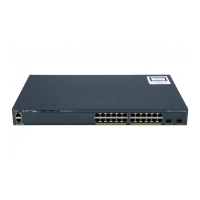1-15
Catalyst 2960 and 2960-S Switches Software Configuration Guide, Release 15.0(1)SE
OL-26520-01
Chapter 1 Overview
Features
–
SRR as the scheduling service for specifying the rate at which packets are dequeued to the
egress interface (shaping or sharing is supported on egress queues). Shaped egress queues are
guaranteed but limited to using a share of port bandwidth. Shared egress queues are also
guaranteed a configured share of bandwidth, but can use more than the guarantee if other queues
become empty and do not use their share of the bandwidth.
Note To use egress queueing, the switch must be running the LAN Base image.
• Auto-QoS enhancements that add automatic configuration classification of traffic flow from video
devices, such as the Cisco Telepresence System and Cisco Surveillance Camera.
Note To use Auto-QoS enhancements, the switch must be running the LAN Base image.
Layer 3 Features
• When you configure the lanbase-routing SDM template, the switch supports static routing and
router ACLs on SVIs (supported only on switches running the LAN base image).
• IPv6 default router preference (DRP) for improving the ability of a host to select an appropriate
router (requires the LAN Base image)
Power over Ethernet Features
• Ability to provide power to connected Cisco pre-standard and IEEE 802.3af-compliant powered
devices from Power over Ethernet (PoE)-capable ports if the switch detects that there is no power
on the circuit.
• Support for IEEE 802.3at, (PoE+) that increases the available power that can be drawn by powered
devices from 15.4 W per port to 30 W per port (Catalyst 2960-S only)
• Support for CDP with power consumption. The powered device notifies the switch of the amount of
power it is consuming.
• Support for Cisco intelligent power management. The powered device and the switch negotiate
through power-negotiation CDP messages for an agreed power-consumption level. The negotiation
allows a high-power Cisco powered device to operate at its highest power mode.
• Automatic detection and power budgeting; the switch maintains a power budget, monitors and tracks
requests for power, and grants power only when it is available.
• Ability to monitor the real-time power consumption. On a per-PoE port basis, the switch senses the
total power consumption, polices the power usage, and reports the power usage.
Universal Power over Ethernet Features
• Provides the ability to source up to 60 W of power over standard Ethernet cabling infrastructure.
• Sources up to 60 W of power (2X 30W) over both signal and spare pairs of the RJ-45 Ethernet cable
based on IEEE802.3at standards.
• Automatically detects UPoE-compliant power devices and negotiates power up to 60 W by using
Layer-2 power negotiation protocols, such as CDP or LLDP.

